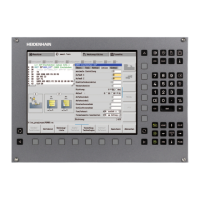January 2012 8.1 PLC Functions 1481
8 PLC Programming
8.1 PLC Functions
The integrated PLC of the control contains its own text editor for creating the
statement list for the PLC program. You enter PLC commands and comments
using an optional USB keyboard. An even simpler way is to create your PLC
program on a PC with the PLC development software PLCdesignNT. If you
want to use PLCdesignNT, please contact HEIDENHAIN.
The control supports you with the COMPILE function, which compiles the PLC
program and checks it for logical errors, and the API DATA, TABLE, TRACE
and WATCH LIST functions, with which you can check the status of the PLC
operands.
The control starts the PLC cycles at the clock rate of the PLC cycle time. In
MP_plcCount, you set the PLC cycle time to a multiple of the IPO clock. Use
Module 9196 to determine the PLC cycle time setting.
MP_ipoCycle
Cycle time of position controller (interpolation clock pulse)
Format: Selection menu
Selection: 3 ms
At present, only a cycle time of 3 ms for the position controller
is supported. Therefore no other values can be selected.
Default: 3 ms
Access: LEVEL3
Reaction: RESET
MP_plcCount
PLC cycle time (Look Ahead cycle time)
Format: Numerical value
Input: 3 to 10 [ · MP_IpoCycle]
The PLC and the Look Ahead run at a clock rate that is a multiple
of the IPO clock (interpolation clock). The Look Ahead function
is triggered exactly two IPO clock pulses after the PLC.
Default: 7
Access: LEVEL3
Reaction: RESET
Module 9196 Find the PLC cycle time
The PLC cycle time is determined in µs.
Call:
CM 9196
PL D <PLC cycle time in [µs]>
Settings in the configuration editor MP number
System
CfgCycleTimes
ipoCycle
plcCount
100301
100302

